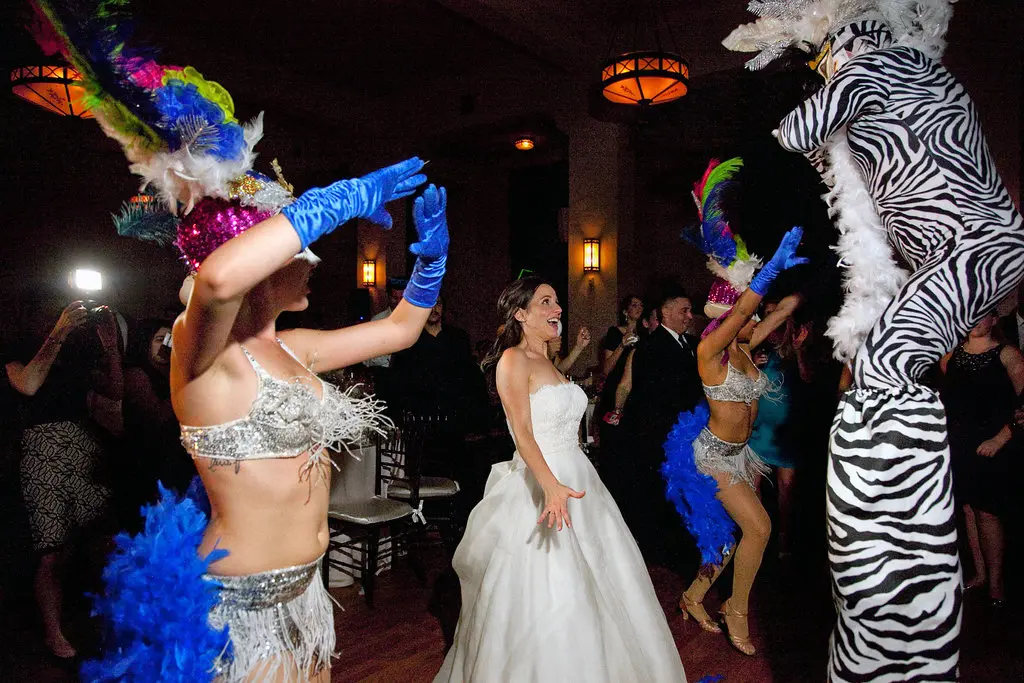The celebration began with the deep beat of drums, setting the energy in motion. Moments later, dancers adorned in sequins and rhinestones appeared, their extravagant headdresses nearly touching the ceiling. Towering stilt-walkers moved gracefully nearby, while feather boas, glowing masks, neon sticks, and bursts of confetti filled the air, it felt like a surprise Mardi Gras had arrived.
But this wasn’t Carnival, it was the wedding of Dr. Shauna Berry and Adam Korenfield, held on July 4 at the Fontainebleau Hotel in Miami Beach. Despite not having Latin roots, the couple embraced hora loca, a festive tradition with origins in South America, to elevate the party atmosphere during their reception.
Described by Martha Stewart Weddings’ special projects editor, Anthony Luscia, as a “transition between the formal reception and the late-night party,” this vibrant interlude usually lasts about 45 minutes, not quite a full hour, but enough to shift the mood entirely. “Though well known in Latin America and Miami,” he added, “many people have never experienced it.”
Jung Lee, an event planner at Fête NY who has curated several hora loca celebrations for weddings, puts it simply: “Every culture brings something special to the party, but no one celebrates quite like Latinos. I love that we can take inspiration from it and make it feel authentic.”
The rise of the hora loca is just one example of how modern weddings are blending traditions from around the world. It’s part of a growing trend where couples borrow meaningful rituals from other cultures to personalize their celebrations. For instance, many Christian couples now choose to marry under a huppah, a traditional Jewish wedding canopy and even incorporate the symbolic breaking of a glass to close the ceremony.
Wardrobe changes throughout the night, once mostly seen in Asian weddings, have become more common in other communities too. Meanwhile, festive elements like New Orleans-style second lines, where the wedding party dances through the streets waving parasols and handkerchiefs, or the Indian baraat, a lively groom’s entrance on a decorated horse accompanied by music and dancing are making their way into weddings of all backgrounds.
“I’ve seen non-Indian grooms recreate the baraat with their own twist,” said Anthony Luscia. “Instead of a horse, they might roll up in a car blasting rap, hopping in and out to hug guests and strangers alike.”
For Dr. Shauna Berry and Adam Korenfield, choosing to include a hora loca in their wedding was all about capturing the spirit of Miami, but in a fresh and unexpected way. “We wanted something that felt like Miami, without going for the usual rice and beans or paella stations,” explained Dr. Berry, 28, currently completing her residency in ophthalmology in the city. To bring the idea to life, their planner, Carrie Zack, partnered with Black & Wine, a company that provided both the performers and the live music for the show.
The hora loca usually unfolds near the end of the evening, just when guests are beginning to lose steam. The lights go low, the drums start pounding, sirens echo through the room, and the energy explodes. Within minutes, the dance floor is full, and even the catering staff can’t resist joining the action.

Mirae Bunnell, 47, and Jay Mulligan, 55, from Chesterfield, Missouri, have always been passionate about Aruba’s vibrant Carnival held each February. So when they tied the knot at the Hyatt Regency in Aruba on June 18, the bride decided to bring some of that festive spirit into their big day. “It felt like the perfect way to add a local touch and boost the energy after dinner,” she explained.
Given how deeply rooted Hispanic culture is in Miami, it’s no surprise that many top hotels now include hora loca as part of their wedding offerings. Properties like the Carillon Hotel & Spa, the Bonaventure Resort & Spa, and the Conrad have embraced the trend and made it a staple of their celebration packages.
According to Elda Brouwer, director of catering sales at The Ritz-Carlton Key Biscayne, “Most non-Latino couples are requesting it now.” She added that hora loca segments often conclude with fun comfort food like mini pizzas, hot dogs, and empanadas. The cost typically ranges between $500 and $3,000, depending on the scope of the performance.
This cultural phenomenon has also spread far beyond Miami. In Skaneateles, a picturesque lakeside town in upstate New York, a wedding two years ago featured a full hora loca experience, complete with masks, hats, feather boas, and oversized sunglasses handed out as guests hit the dance floor.
More recently, in May, John Macaluso from Mystical Entertainment Group in Nutley, New Jersey, surprised 330 wedding guests, including the bride and groom, with a full hora loca show during his brother Joe’s wedding to Charla Belfiore.
“I think every wedding should have a wow moment,” Macaluso said. “And the hora loca absolutely delivers that wow.”

